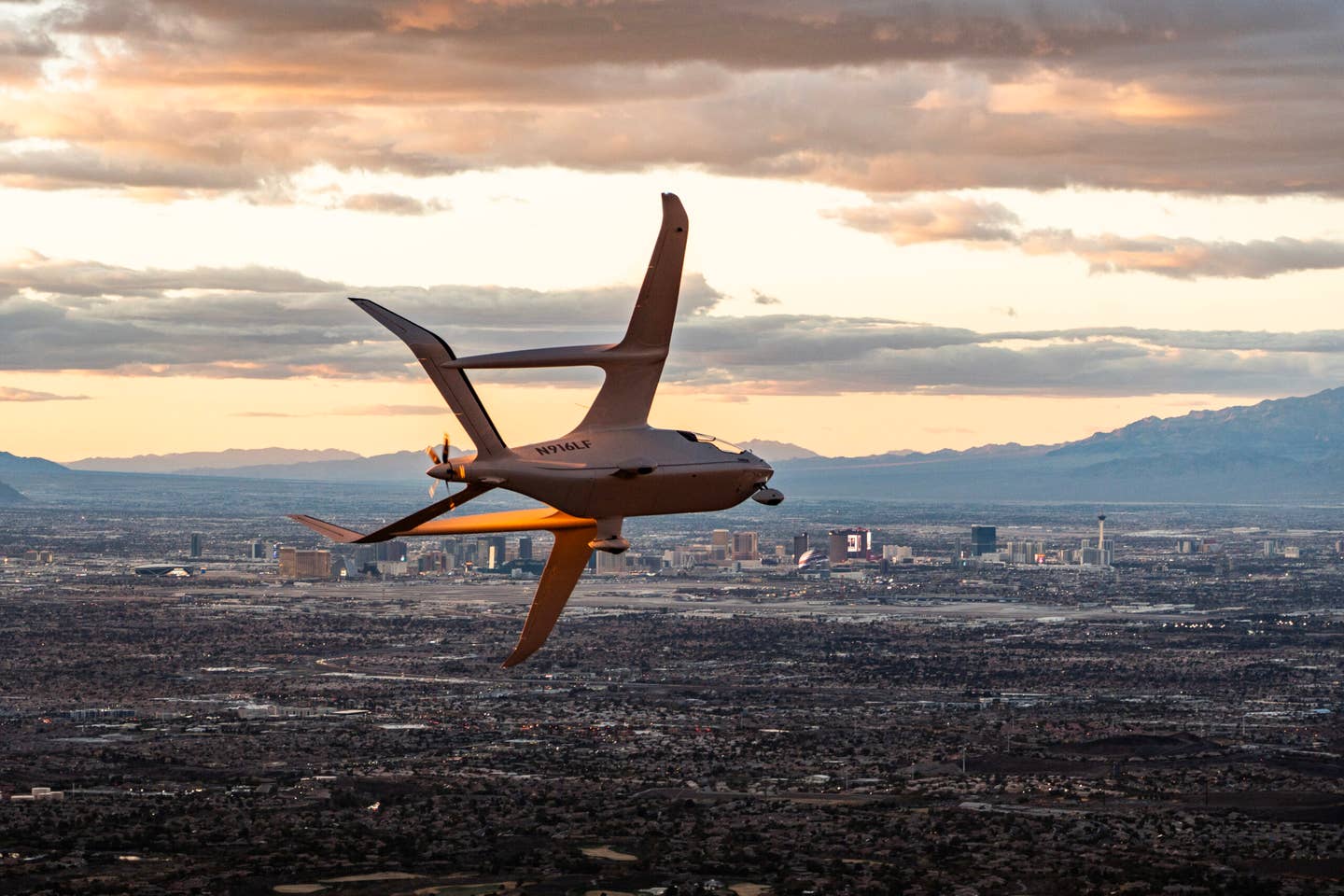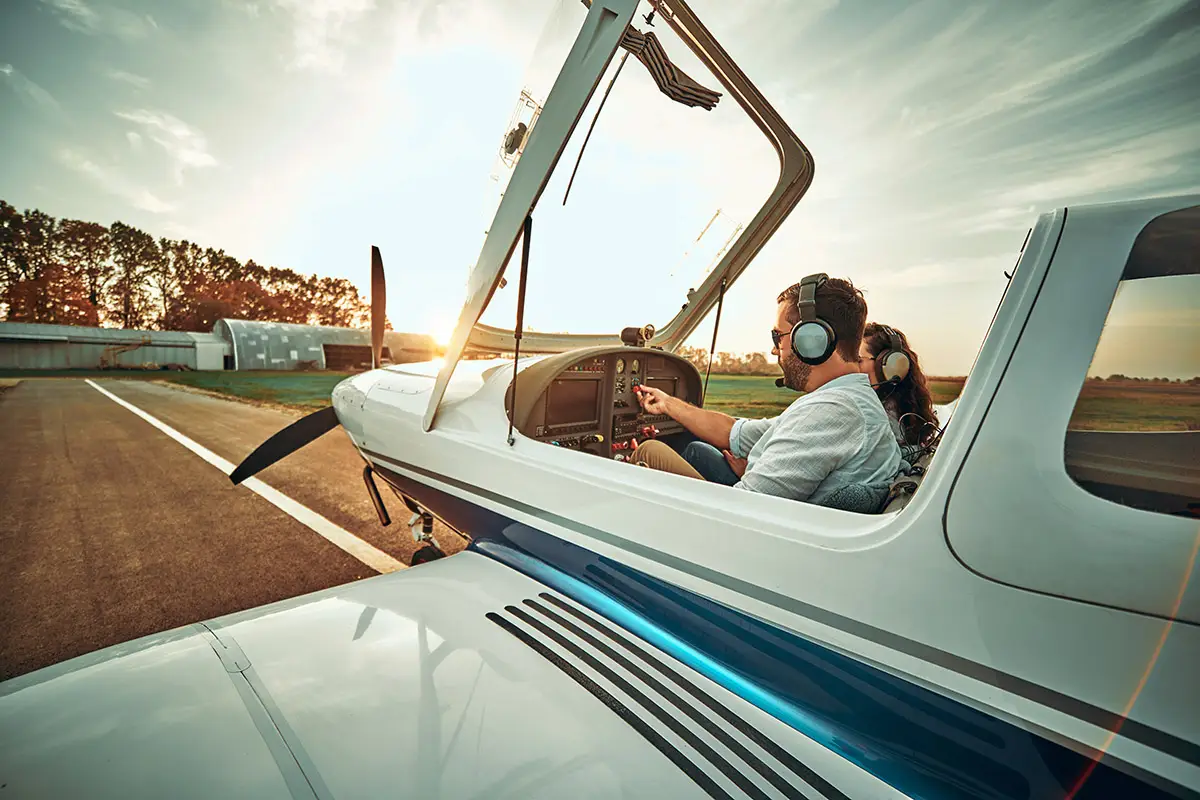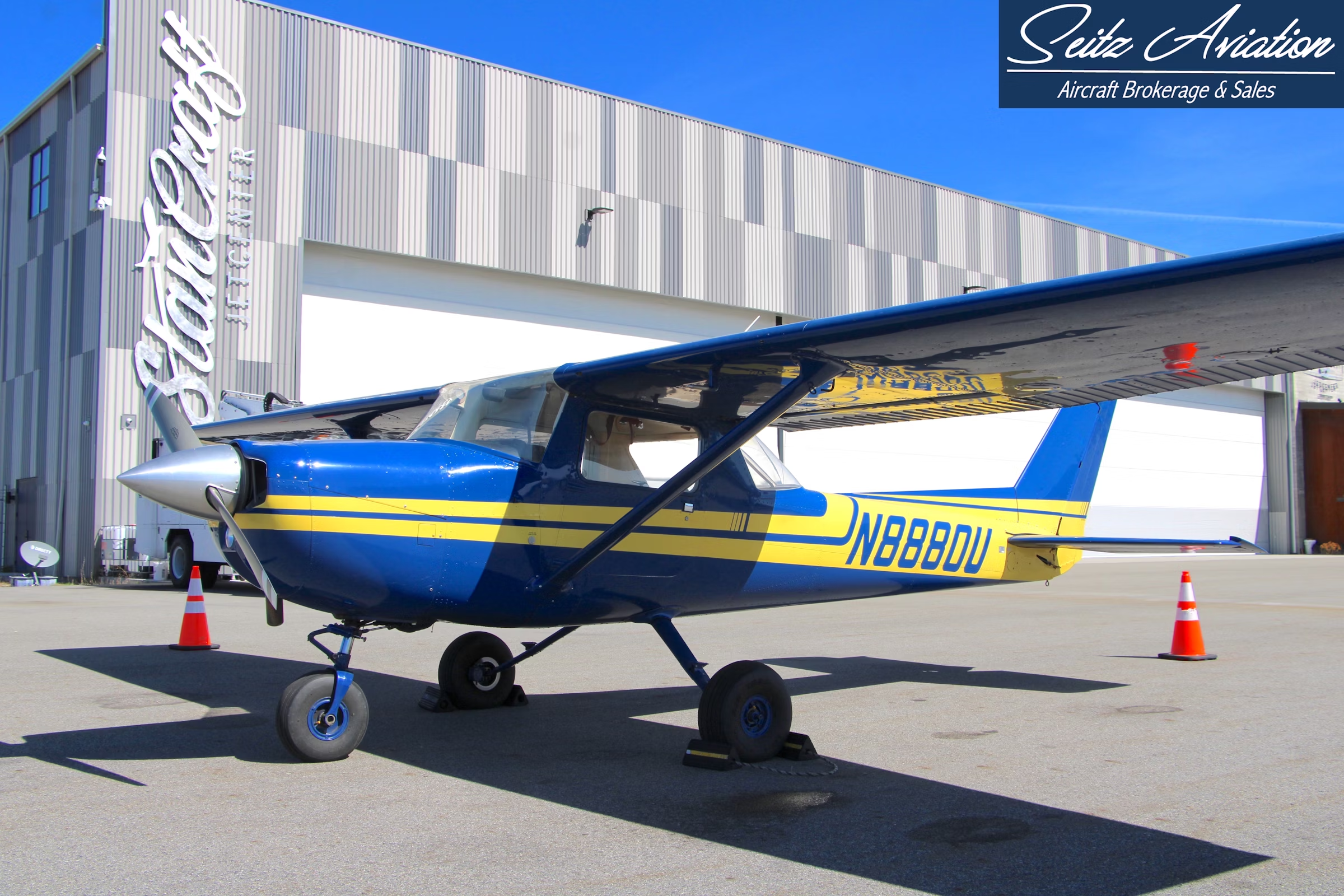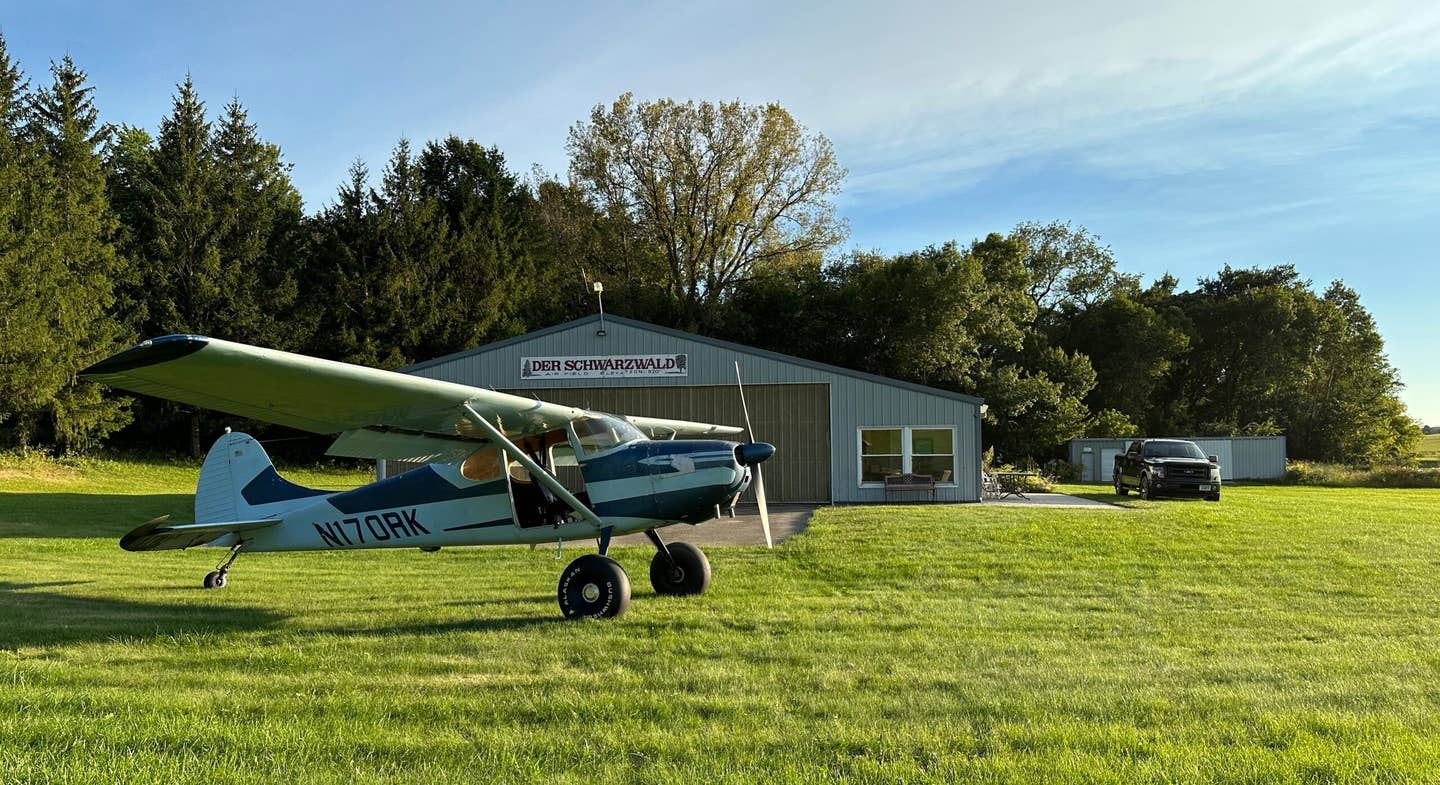Electric Aircraft Completes 6-Week, 22-State Cross-Country Journey
Beta’s CX300 flies from the manufacturer’s flight test center in New York to California and back again.

Beta’s CX300 electric aircraft travelled from New York to California and back, flying in VFR, IFR, day, and night conditions. [Courtesy: Beta Technologies]
During its barnstorming, six-week tour of the U.S., Beta Technologies’ CX300 production-intent electric aircraft was greeted with wide eyes—both of excitement and confusion.
“That’s a pretty, uh, different looking aircraft there—what is that thing?” the pilot of a Cessna 177 Cardinal asked Beta test pilot Chris Caputo during an in-air meetup in Utah.
“That thing would be called a Beta Technologies CX300 all-electric conventional takeoff and landing aircraft,” Caputo replied. “Be on the look out, you’re going to see a lot more of them.”
The aircraft—tail number N916LF, the first to be rolled off Beta’s scaled production line in Burlington, Vermont last year—recently returned to Plattsburgh International Airport (KPBG) after visiting more than 20 states and 82 municipal, state, and military airfields. The journey took the CX300 from Plattsburgh to Santa Monica, California, and back, flying over the Hollywood sign in Los Angeles, the mountainous Continental Divide, Midtown Manhattan, and other iconic landmarks.
The aircraft completed up to four flights per day, Beta said. It is designed for a pilot and up to five passengers, with a top cruise speed of 135 knots and demonstrated range of 336 nm, per the company's website. Beta claims the CX300 will produce 75 percent less emissions than a Cessna 208 Caravan at a fraction of the energy cost per hour.
“Seeing some iconic American scenes like the Grand Canyon from the cockpit was truly special,” Beta test pilot Nate Dubie, who along with Caputo and test pilot Noah Ranallo flew the aircraft in shifts, said in a statement. “But just as exciting was the enthusiasm from so many communities across the country who wanted to learn about this aircraft and the technology behind it.”
The trip was more than a public relations exercise, though. N916LF flew in VFR, IFR, day, and night conditions through snowstorms and scorching heat—an impressive validation of its systems considering Beta registered the model with the FAA less than six months ago.
Along the way, the aircraft used Beta’s network of electric chargers to juice up, proving it is possible to fly an electric aircraft from coast-to-coast. It even demonstrated routes that could be operational ahead of the 2034 Winter Olympic Games in Salt Lake City, which Beta and its partners and Utah plan to use as a showcase for the technology.
“This trip was a great way to put the aircraft and infrastructure through their paces ahead of delivering to customers this year,” said Dubie.
The model flew under Part 23 rules and a special airworthiness certificate from the FAA obtained after 50 hours of flight testing, Beta said.
I’ve Been Everywhere
The first half of the CX300’s journey, which the firm dubbed the “Beta Barnstorm,” spanned 22 days, 20 flight legs, more than 3,000 nm, and 11 states.
N916LF lifted off from Plattsburgh on February 7, stopping at airports in Glens Falls, Rome, Rochester, and Jamestown in New York while battling frigid weather. Those conditions snowballed into a blizzard by the time it reached Akron and Cincinnati in Ohio, continuing as it traveled south through Indiana, Arkansas, Missouri, and Oklahoma.
The snow was soon replaced by scorching desert heat as the aircraft flew through Texas, New Mexico, and Arizona, making stops in Amarillo, Albuquerque, Gallup, and Winslow. It landed at Santa Monica Municipal Airport (KSMO) on March 1, completing the coast-to-coast trip.
Nine days later, N916LF arrived at Salt Lake City International Airport (KSLC) for the first of six public flight demonstrations in Utah, where Beta is working with the state and partner 47G to introduce advanced air mobility (AAM) routes and charging sites. It flew more than 304 nm across the state, demonstrating potential cargo and passenger routes.
Stops included Heber, which Beta described as a “future charging site and transit hub,” and Ogden, which it said will have a “major role in future Olympic operations.” Nearly 1,000 spectators attended the flights, including civilians and state officials.
“There’s an opportunity ahead of the Olympics for Utah to lead the nation in [AAM]. To be put on the map in a whole new way,” Aaron Starks, president and CEO of 47G, said in a statement.
While in Salt Lake City, the CX300 took part in an operational demonstration with Beta customer UPS Flight Forward, which in 2021 signed a deal to purchase up to 150 electric vertical takeoff and landing (eVTOL) Alia aircraft. Beta is developing cargo and passenger versions of both the CX300 and Alia, scheduled to enter service this year and next, respectively. UPS personnel loaded and unloaded the aircraft and simulated a feeder route.
Before arriving back in Plattsburgh, N916LF achieved one more feat: an IFR flight into Hartsfield-Jackson Atlanta International Airport (KATL), the busiest airport in the world.
Setting the Stage
The CX300’s extraordinary journey was a sight to behold. It was also a preview of what’s to come.
As soon as this year, Beta plans to kick off customer deliveries and certify the model for commercial service. It claims to have a backlog of 600 aircraft. UPS Flight Forward, United Therapeutics, and other cargo and medical delivery providers will likely get a crack at the CX300 before passenger operators.
During the aircraft’s cross-country journey, Beta said it introduced the technology to nearly 150 FAA personnel. The manufacturer last month also flew a second production-intent CX300 that will conduct flight testing in Norway for customer Bristow Group, which specializes in search and rescue and offshore operations.
Once the FAA certifies the model, Beta’s network of chargers could allow it to launch service nationwide. The company has agreements with FBO networks Atlantic Aviation and Signature Aviation to install chargers in their terminals. Competing eVTOL manufacturers Archer Aviation and Vertical Aerospace have even purchased them for their own designs.
Having accrued extensive real-world action, Beta’s CX300 could be one of the first crewed electric aircraft authorized by the FAA to carry passengers or cargo. The U.S. is aiming to keep pace with China, which last month certified a four-seat electric model for commercial service. This week, it authorized EHang’s self-flying electric model to carry humans.
Like this story? We think you'll also like the Future of FLYING newsletter sent every Thursday afternoon. Sign up now.

Sign-up for newsletters & special offers!
Get the latest FLYING stories & special offers delivered directly to your inbox






